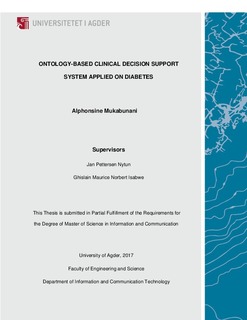| dc.description.abstract | Medical diagnosis is a multi-step process which is complex as it requires the consideration of many factors. Additionally, the accuracy of diagnosis varies depending on the skill and knowledge a physician has in the medical field. Using ICT solution, the physicians can be assisted so that they can make an accurate decision. Many applications have been developed to enhance physician performance and improve the patient outcome, however, the quality of these applications varies depending on knowledge representation methodology and reasoning approach adopted. Nowadays, ontology is being used in many clinical decision support as it formally represents the concepts and relationships of terms associated with medical domains which in turn improves the information processing, retrieval, and decision support. However, some of these applications do not explain their reasoning process; their knowledge base may not be built using the standard medical ontologies and they build ontology but fail to develop an application that a physician can use.
The main objective of this thesis was to investigate how an ontology and its generic tools can be used to overcome the above challenges; how diagnostic can be formally represented and to implement a clinical decision support system that uses that ontology and diagnostic criteria to assist physician when making a diagnosis of diabetes mellitus.
The ontology extends DDO and has been designed in protégé 5.0.0 OWL-DL. 19 rules were created based on diabetes diagnostic criteria by using jena rule syntax and forward chaining inference. Furthermore, the system uses the jena rule engine to reason with patient data from ontology against the rules defined in a rule file to generate a patient diagnosis, recommendation and decision explanation based on the patient vital signs and blood glucose test result. As result, 4 patient’s case was successful diagnosed; recommendation and decision explanation produced by the system undoubtedly matched the patient diagnosis. Overall system result is the same as the one expected by the physician, thus, makes it an expert system. The ontology supports the interoperability between CDSS and healthcare system and can be used for the management of the patient.
Keywords: Clinical decision support system, diagnostic criteria, semantic web, ontology, diagnosis | nb_NO |

